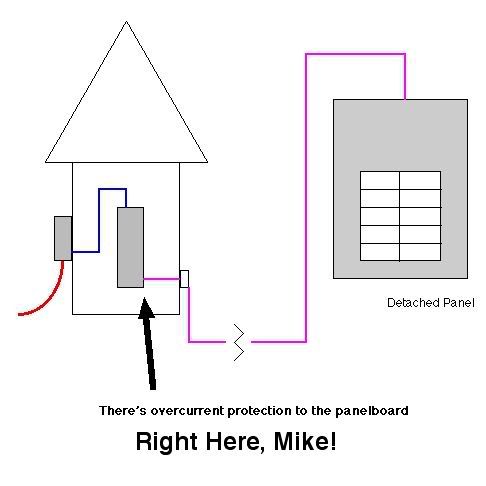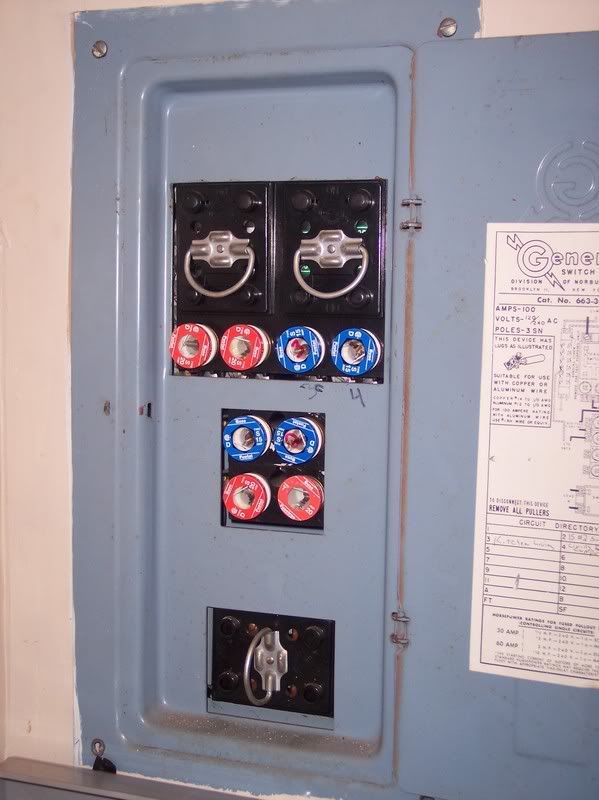- Location
- Windsor, CO NEC: 2023
- Occupation
- Hospital Master Electrician
Re: 6 disconnect rule violation?

The feeder protecting the panelboard to a detached structure is necessarily going to have overcurrent protection, agreed?
I'm not saying that this remote OCPD acts as the disconnecting means at the remote structure, it's acting as the overcurrent protection. The feeder is protected, as is the panelboard. So 408.36(A) is satisfied when you're talking about a 225-governed installation.
408.36(A) makes no comment about where the overcurrent protection is, it doesn't care.
So:
If a lighting & appliance panelboard is to be used for service equipment, then 408.36(A) states that it does need a main, and that is reinforced by Exception No 2, which states that existing installations used as service equipment can sit as they are, without individual protection.
If a lighting & appliance panelboard is to be used for a (225-governed) detached building, the one-line would be as follows:
Service >
Main Breaker >
Main Feeder >
Main Panel >
Feeder OCPD >
Underground Feeder Cable (UF/ URD) >
L&A-BC-PB enclosure >
Up to 6 handles, or main over that >
Branch circuits
A detached building would be able to use any size MLO panel, provided:
</font>
Whadya think?
No reading things closely - the thread will die.Originally posted by jwelectric:
A real close reading of 408.36 will find an exception;
Exception No. 1: Individual protection for a lighting and appliance panelboard shall not be required if the panelboard feeder has overcurrent protection not greater than the rating of the panelboard.
I think you're confusing "overcurrent protection" and "disconnecting means", Mike. Nothing gets knocked down, I think these two codes work hand in hand.This exception is knocked down by the rule found in 225.31 and 32 which states that the separate building is required to have a disconnecting means either inside or outside.
The feeder protecting the panelboard to a detached structure is necessarily going to have overcurrent protection, agreed?
I'm not saying that this remote OCPD acts as the disconnecting means at the remote structure, it's acting as the overcurrent protection. The feeder is protected, as is the panelboard. So 408.36(A) is satisfied when you're talking about a 225-governed installation.
408.36(A) makes no comment about where the overcurrent protection is, it doesn't care.
So:
If a lighting & appliance panelboard is to be used for service equipment, then 408.36(A) states that it does need a main, and that is reinforced by Exception No 2, which states that existing installations used as service equipment can sit as they are, without individual protection.
If a lighting & appliance panelboard is to be used for a (225-governed) detached building, the one-line would be as follows:
Service >
Main Breaker >
Main Feeder >
Main Panel >
Feeder OCPD >
Underground Feeder Cable (UF/ URD) >
L&A-BC-PB enclosure >
Up to 6 handles, or main over that >
Branch circuits
A detached building would be able to use any size MLO panel, provided:
</font>
- <font size="2" face="Verdana, Helvetica, sans-serif">225.32, It's outside, give or take</font>
- <font size="2" face="Verdana, Helvetica, sans-serif">225.33(A), There are not more than 6 handles,</font>
- <font size="2" face="Verdana, Helvetica, sans-serif">225.36, it's marked as suitable for use as service equipment</font>
- <font size="2" face="Verdana, Helvetica, sans-serif">225.39(A)(B)(D), the one handle is rated 15, the two handles add up to 30, or all of them add up to 60.</font>
- <font size="2" face="Verdana, Helvetica, sans-serif">225.40, the feeder OCPD from the originating building is readily accessible or the crutches offered are used.</font>
Whadya think?


